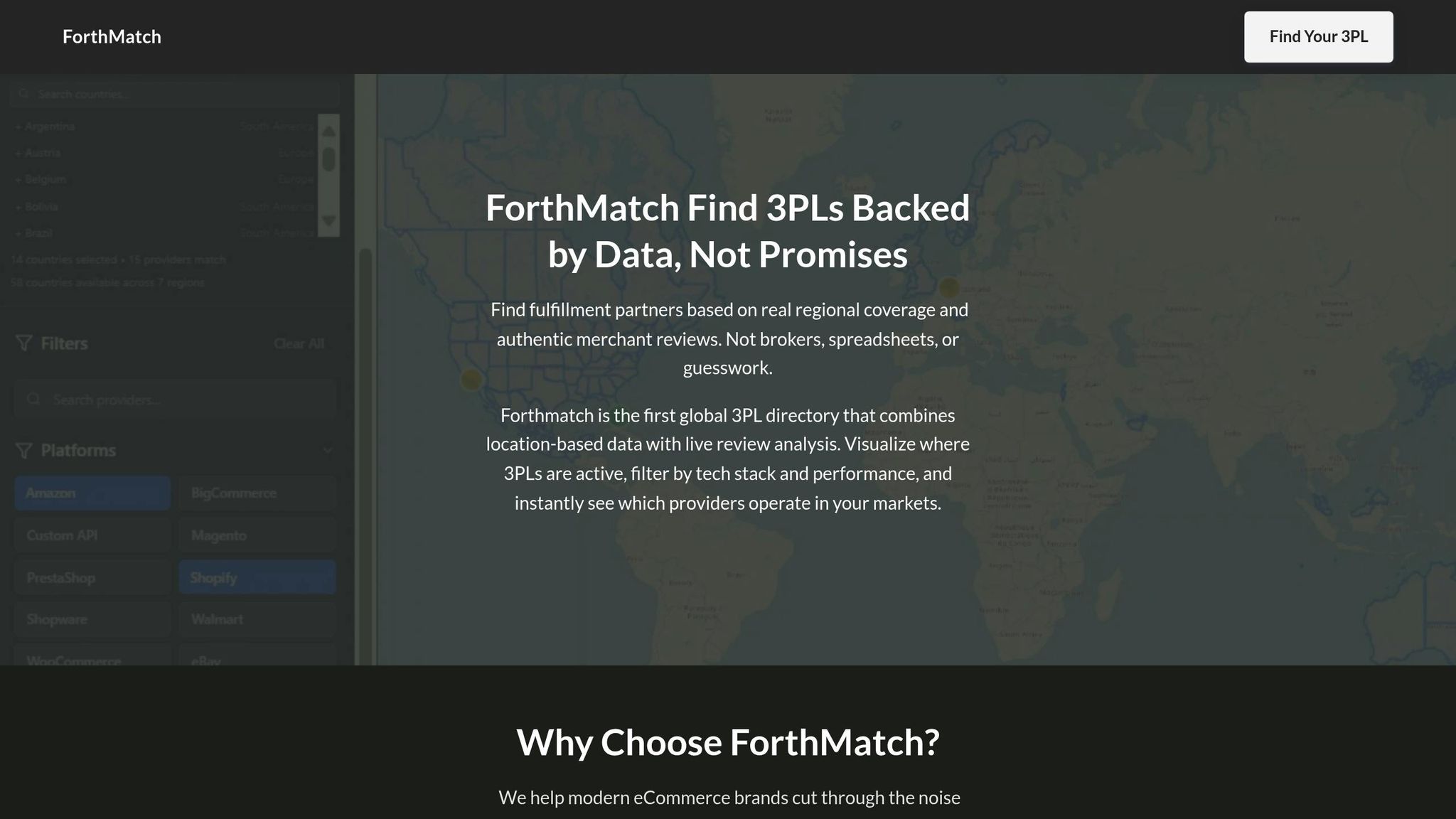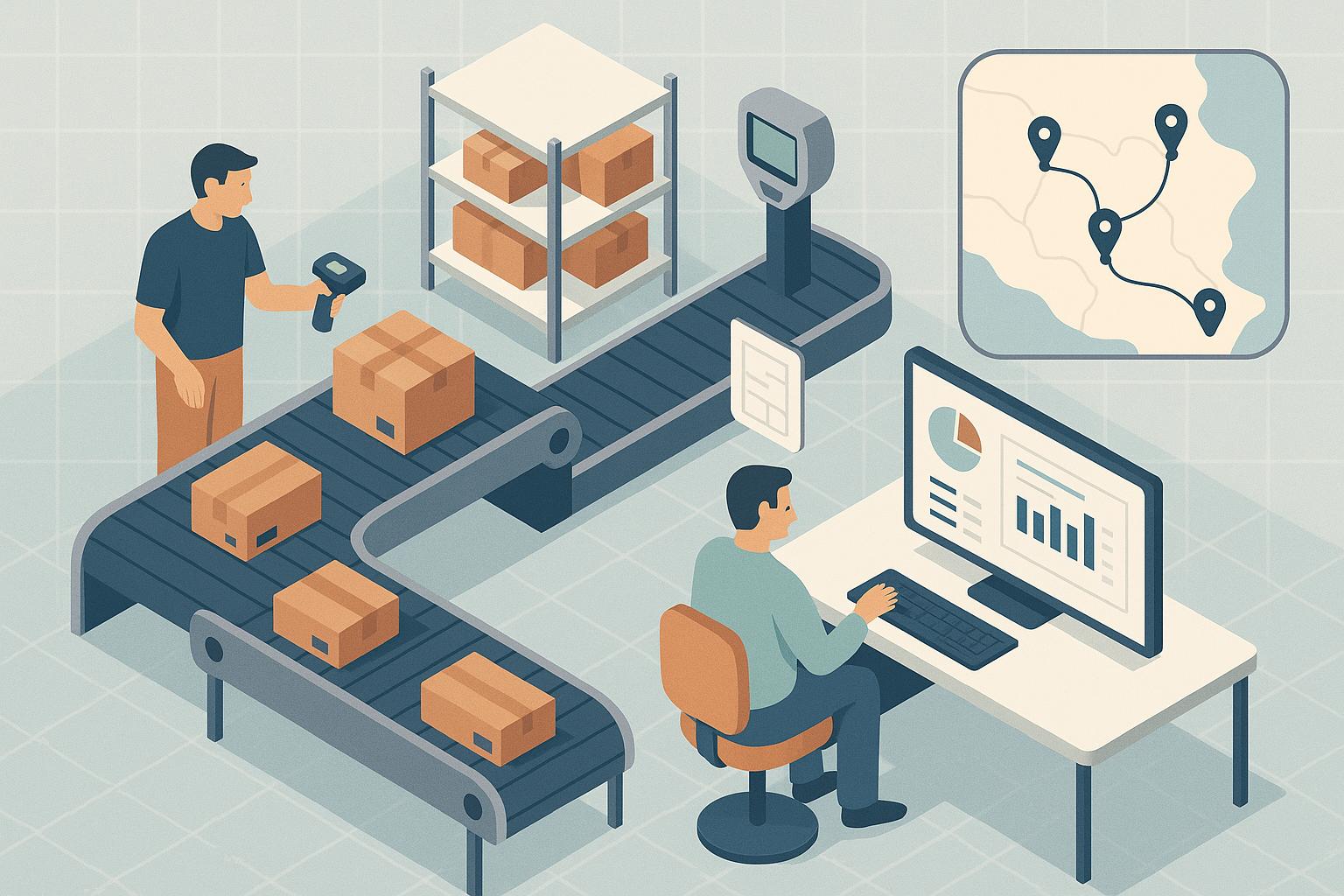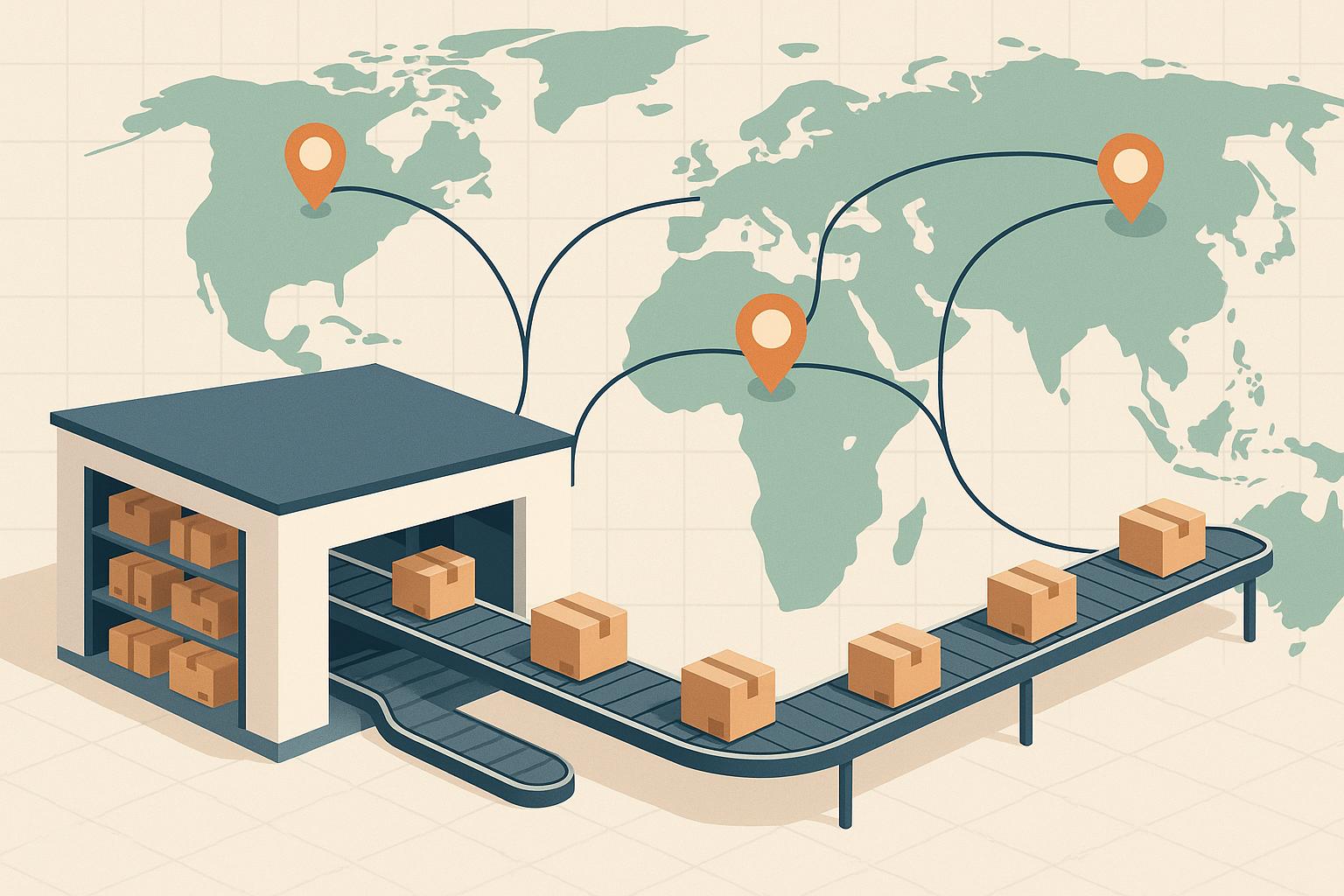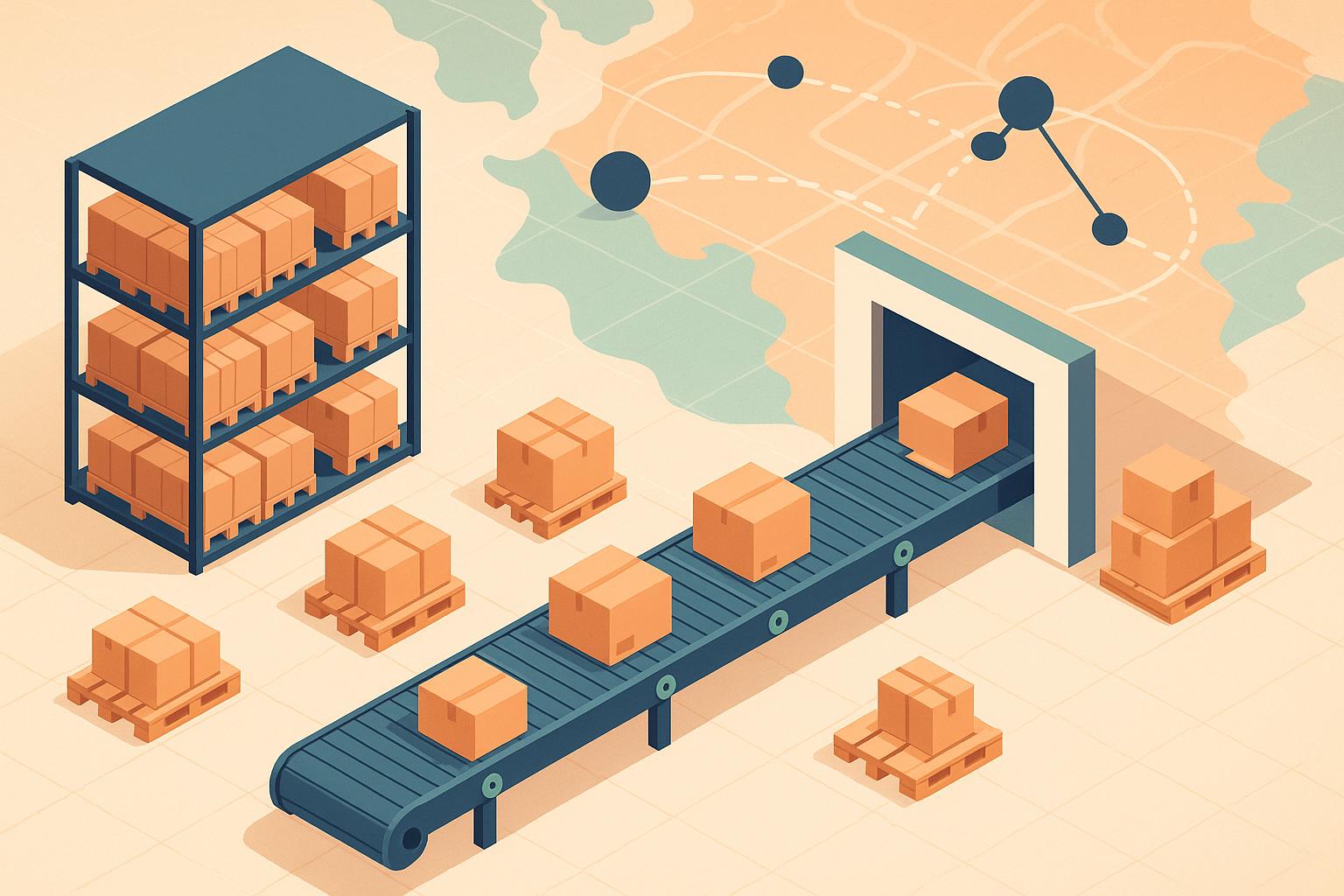3PL integration connects your eCommerce platform with third-party logistics providers to handle warehousing, fulfillment, and shipping. Automating this process ensures orders are processed instantly, inventory updates are accurate, and shipping is faster - key for scaling your direct-to-consumer (DTC) brand.
Key Takeaways:
- Automation eliminates manual tasks: APIs and webhooks sync orders, inventory, and shipping data in real-time.
- Customer satisfaction improves: Faster processing, real-time tracking, and accurate inventory updates enhance the shopping experience.
- Scalability is easier: Automation handles high order volumes, especially during peak times like Black Friday.
- Choosing the right 3PL matters: Evaluate providers for platform compatibility, delivery zones, and pricing transparency.
Tools like Forthmatch can simplify finding and connecting with 3PL providers by offering a directory of vetted partners tailored for DTC brands.
To get started:
- Review your tech stack: Ensure your eCommerce platform supports APIs (e.g., Shopify, WooCommerce) and syncs with order and inventory systems.
- Set clear goals: Define targets for shipping speed, inventory updates, and cost efficiency.
- Test and monitor: Use staging environments to test workflows and track performance metrics like order processing time and inventory accuracy.
Automation isn't just convenient - it’s necessary for growing your DTC business.
AI for Ecommerce Ops - A Tactical Guide for 3PL Connected Brands
Getting Your Business Ready for 3PL Integration
Laying the groundwork is key to ensuring a smooth transition to 3PL automation. This involves both assessing your current technology and setting strategic goals to align with your automation plans.
Review Your Current Tech Stack
Your existing tech stack plays a vital role in determining how successfully you can integrate with a 3PL provider. Start by reviewing your eCommerce platform to confirm it supports API connections for external fulfillment services. For example:
- Shopify: Offers built-in integration through its Fulfillment Service API.
- WooCommerce: Requires plugins like WooCommerce REST API for integration.
- BigCommerce: Provides native webhook support.
- Magento: Offers robust API functionality but may need custom development.
Next, audit your order management systems (OMS) like ShipStation, warehouse management systems (WMS), and inventory tools such as TradeGecko. Make sure these systems can sync seamlessly with 3PL inventory feeds to avoid issues like overselling. Documenting your entire software stack and its integrations is crucial - it helps 3PL providers assess compatibility and pinpoint any technical gaps. With this information in hand, you can also define your integration objectives more clearly.
Define Your Integration Goals
Before diving into the selection process, establish clear and measurable goals for your 3PL automation. Here are some areas to focus on:
- Inventory Updates: Decide whether you need real-time or periodic updates based on your operational needs.
- Order Processing: Set specific targets, such as "orders placed before 2:00 PM ship the same day", to evaluate 3PL performance later.
- Geographic Reach: Pinpoint delivery goals, like "2-day ground shipping to 80% of U.S. addresses."
- Cost Efficiency: Set measurable goals, such as reducing the average shipping cost per order by 15%.
- Scalability: Plan for seasonal peaks. For instance, if your order volume spikes by 300% during Black Friday, ensure your automation can handle these surges without requiring manual adjustments.
Once your goals are clearly defined, you’ll be in a better position to identify 3PL partners that align with your needs.
Use Forthmatch to Identify 3PL Partners

Forthmatch makes finding the right 3PL provider easier by offering a directory of vetted logistics companies tailored for direct-to-consumer (DTC) brands. The platform eliminates broker fees and hidden markups, streamlining the search process. Here’s how it helps:
- Platform Compatibility: Filter options to find 3PLs that integrate smoothly with your eCommerce system.
- Delivery Zone Mapping: Access real-time maps to visualize service areas and plan geographic coverage.
- Transparent Communication: Contact providers directly, skipping middlemen to speed up evaluations and ensure open pricing discussions.
- Community Reviews: Read feedback from other DTC merchants to gain insights on integration ease, customer support, and delivery performance.
- Trust Scoring: Use data-driven scores to identify reliable partners based on performance metrics.
With these tools, you can quickly narrow down your options and find a 3PL provider that meets your specific requirements for delivery regions, specialty services, and seamless integration.
Choosing and Connecting with the Right 3PL Partner
After preparing your business for integration, the next step is finding and evaluating the right third-party logistics (3PL) partner. This involves balancing operational needs with technical requirements to ensure a seamless transition to automation.
Create a Shortlist of 3PL Providers
Start by narrowing down potential 3PL providers based on your specific needs. One of the first things to assess is their geographic coverage. A provider that can't efficiently reach your primary customers may hinder your ability to grow.
Tools like Forthmatch can help you visualize delivery zones and connect directly with providers. This makes it easier to confirm whether their service areas align with your shipping requirements.
When it comes to cost, prioritize transparency. Look for providers that clearly outline their pricing structures, including storage fees, pick-and-pack charges, and any costs associated with special handling or returns. Clear pricing helps safeguard your profit margins.
Merchant reviews are another valuable resource. Focus on feedback from businesses similar to yours in terms of order volume and product type. Pay close attention to comments about integration ease, customer service, and how the provider handles peak seasons or unexpected surges in demand.
It's also beneficial to contact providers directly rather than going through brokers. This allows for more straightforward discussions about their capabilities and any limitations. When reaching out, ask specific questions about their experience with your eCommerce platform, typical order processing times, and how they resolve inventory discrepancies.
Once you've narrowed down your options, the next step is verifying their technical integration capabilities to ensure a smooth onboarding process.
Check Technical Integration Requirements
With your shortlist in hand, it's time to confirm that the 3PL providers can meet your technical needs - this is critical for successful automation. Most modern 3PLs offer APIs (Application Programming Interfaces) that enable real-time data sharing for inventory updates, order statuses, and shipping confirmations. However, the quality and functionality of these APIs can vary significantly.
If you're planning to scale your operations or work with larger retail partners, EDI (Electronic Data Interchange) support becomes essential. Unlike APIs, which excel in real-time communication, EDI provides standardized document exchange that enterprise clients often expect. Make sure your potential 3PL partner supports common EDI transaction types like 850 (Purchase Orders), 856 (Advance Ship Notices), and 810 (Invoices).
Platform-specific integrations can also simplify the setup process. For example, if you're using Shopify, seek out 3PLs with native Shopify apps. Similarly, WooCommerce users should look for providers with tested plugin integrations that eliminate the need for custom API development.
Another key factor is the frequency of data synchronization. Some 3PLs update inventory levels every 15 minutes, while others sync only once or twice a day. For businesses handling high volumes or managing limited stock, frequent updates are crucial to avoid overselling.
High-quality 3PLs often offer staging environments for testing. This allows you to simulate order flows, inventory updates, and error handling before going live - an invaluable feature if downtime isn’t an option for your business.
Webhook support is another helpful feature, enabling your systems to receive instant notifications for important events like order fulfillment, shipping confirmations, or inventory changes. This eliminates the need for constant polling and ensures your customers receive timely updates.
When evaluating technical capabilities, always request detailed API documentation. Look for information on endpoints, rate limits, and error-handling procedures. A well-documented API with clear examples and responsive technical support indicates a provider that can effectively support your automation goals.
sbb-itb-eb0f906
Setting Up Automated Workflows with Your 3PL Partner
Once you've nailed down the technical requirements, the next step is automating the data flow between your systems. This process requires thoughtful planning, accurate execution, and thorough testing to ensure seamless communication between your eCommerce platform and your 3PL.
Connect Data Between Systems
After confirming integration capabilities, it's time to align your data fields to ensure everything syncs correctly. Effective automation hinges on precise data mapping between your systems and your 3PL.
- Synchronize your product catalog: Map internal SKUs, dimensions, weights, and any special handling instructions to your 3PL's system.
- Ensure accurate order mapping: Align shipping addresses, product quantities, shipping methods, and special instructions to avoid fulfillment mistakes.
- Real-time inventory updates: Synchronize inventory levels to prevent overselling. The update frequency should match your sales volume to keep things running smoothly.
- Integrate return workflows: Return merchandise authorization (RMA) processes should flow seamlessly. When a customer initiates a return, your 3PL should automatically receive details like return reasons, restocking instructions, and refund triggers. This ensures incoming packages are handled efficiently.
Set Up and Test Automation
With data mapping complete, it's time to implement the automation using your preferred integration method.
- Native platform integrations: These are often the easiest to set up. For instance, if you're using Shopify and your 3PL offers a certified Shopify app, you can usually connect your accounts and configure settings through a straightforward interface.
- API integrations: While more technical, APIs offer greater customization. You'll need to set up endpoints for tasks like sending new orders, receiving inventory updates, and tracking shipments. Most 3PLs provide detailed API documentation, often with code examples for popular platforms.
- Middleware solutions: If direct integrations aren't available or if you need more complex logic, middleware can act as a bridge between systems.
Once set up, pilot testing is essential. Use your 3PL's staging environment to simulate various scenarios, such as processing orders, updating inventory, and handling returns. Test error cases too, like invalid addresses or out-of-stock items, to ensure your workflows handle issues gracefully. If your business expects high order volumes, especially during peak seasons like Black Friday, load testing is crucial to avoid disruptions.
Track Performance and Make Improvements
Once workflows are live, the focus shifts to monitoring and refining performance. Keep an eye on key metrics to ensure everything runs efficiently and delivers a great customer experience.
- Order processing time: Measure the time from order placement to shipment. Most automated workflows should process standard orders within 2-4 hours on business days. Any delays could signal system issues or capacity limits.
- Inventory accuracy: Regularly compare inventory levels between your eCommerce platform and 3PL warehouse. Discrepancies can lead to overselling or stockouts, so consider setting automated alerts for variances beyond 2-3%.
- Data sync issues: Monitor for failed API calls, webhook timeouts, or other integration errors. Use tools like Slack or Microsoft Teams to receive real-time alerts for quick resolution.
- Customer satisfaction: Metrics like shipping accuracy, delivery speed, and return processing efficiency are direct indicators of integration success. Complaints about incorrect orders or delays often point to issues in the workflow that need attention.
Schedule regular performance reviews with your 3PL to discuss recurring issues, integration performance, and potential tweaks. These meetings often uncover small adjustments that can significantly improve efficiency.
As your business grows, scalability becomes critical. Monitor how your system performs during peak periods and work with your 3PL to handle increased order volumes. This might involve upgrading API rate limits, optimizing data transfer methods, or adding more robust error-handling measures.
Finally, document any changes you make to workflows over time. Adjustments to product handling, shipping rules, or return processes are inevitable as your business evolves. Clear documentation ensures smoother troubleshooting and helps onboard new team members effectively. These ongoing refinements will keep your logistics running efficiently and support your brand's growth.
Solving Common 3PL Automation Problems
Even with the best preparation, 3PL automation can sometimes hit roadblocks that disrupt your workflow. The good news? Most of these issues are predictable, and with the right approach, you can address them before they escalate. Let’s dive into the common challenges and how to tackle them effectively.
Fix Data and Sync Problems
Data inconsistencies are a frequent culprit behind order delays, inaccurate inventory counts, and shipment hiccups.
SKU mismatches are a classic example. Your internal product codes might not align with the codes used by your 3PL’s warehouse management system. This disconnect can grind order processing to a halt. The fix? Create a mapping table that translates your codes to theirs. Many 3PLs allow you to bulk-upload these mappings, but remember to update them regularly as your product catalog grows.
Inventory sync delays can also cause headaches. If your system’s sync intervals lag behind real-time order activity, you risk overselling. A common workaround is to display only 95% of your actual inventory to account for timing discrepancies.
Address validation failures are another roadblock. Systems often handle addresses differently, especially for international orders, apartment numbers, or PO boxes. Work with your 3PL to establish clear formatting rules and flag orders that don’t meet standards for manual review.
API rate limits can become a bottleneck as your order volume increases. If your system sends too many requests too quickly, your 3PL’s system might temporarily block you. To avoid this, throttle your API requests and coordinate with your 3PL to increase capacity during peak times.
When sync issues arise, error logging becomes your best friend. Set up detailed logs to capture what data was sent, the response received, and where the process went wrong. This information helps both your team and your 3PL quickly pinpoint and resolve problems. Some brands even use automated alerts to notify their teams when sync errors exceed acceptable thresholds.
While resolving sync problems is critical, having strong support systems in place ensures you’re ready for whatever comes next.
Maintain Support and Plan for Growth
Once your technical issues are under control, focus on building a robust support system to keep your automation on track.
Keep your documentation up to date. As your business evolves - whether you’re adding new products, adjusting shipping rules, or tweaking return policies - make sure your integration documentation reflects these changes. This includes mapping tables, API configurations, and workflow diagrams. Keeping everything current makes troubleshooting and onboarding much smoother.
Plan for capacity increases. If you’re preparing for a big marketing push or entering new markets, give your 3PL a heads-up. Proactively communicating your growth plans allows them to scale their systems to meet your needs and helps you avoid bottlenecks during critical periods.
Use monitoring tools to stay ahead. Dashboards that track key metrics, like order processing times or inventory sync accuracy, can help you catch issues early. Set up alerts for performance drops so you can address problems before they affect customers.
Have backup procedures in place. Automation failures happen, but they don’t have to disrupt your business. Develop and regularly test backup workflows to ensure you can maintain operations during system outages.
Build strong vendor relationships. Regular communication with your 3PL is essential. Schedule periodic reviews to discuss performance, address potential issues, and explore new features. Consider implementing service level agreements (SLAs) to set clear expectations for response times. For example, critical issues might require action within an hour, while less urgent matters could have longer timelines.
Finally, as your business grows, expect your integrations to become more complex. Partner with 3PL providers that offer robust APIs and flexible integration options to adapt to your evolving needs.
Conclusion: Improving Logistics Through Automation
Automating your 3PL integration can completely transform your DTC operations. When implemented effectively, automation eliminates manual bottlenecks that slow down order processing, minimizes costly human errors, and allows your team to focus on growing the business instead of juggling spreadsheets.
Start with a detailed tech audit and set clear integration goals to create a strong foundation. Make sure your eCommerce platform, inventory management tools, and customer service systems work seamlessly with your 3PL provider.
Partnering with the right 3PL is a game-changer. That’s where Forthmatch comes in. Instead of wasting weeks researching providers and filling out endless quote forms, you can use Forthmatch to quickly compare vetted 3PLs based on their delivery coverage, platform compatibility, and real merchant reviews. Features like real-time service area maps and advanced filtering options take the guesswork out of the process, helping you make smarter, faster decisions.
Once you’ve secured the right 3PL partner, the focus shifts to the technical integration that powers automation. Data mapping, API connections, and workflow automation become the backbone of your operations.
With automated order routing, packages reach customers faster. Real-time inventory syncing helps prevent overselling and stockouts. And streamlined returns processing boosts customer satisfaction while cutting down on support tickets. These enhancements directly impact your bottom line by improving retention and lowering operational costs.
Even when challenges arise - and they will - having the right systems in place makes resolving them straightforward. Features like error logging, monitoring dashboards, and backup protocols ensure small issues don’t spiral into major disruptions. The key is to build these safeguards into your automation from the start, rather than scrambling to fix problems later.
For DTC brands looking to scale, 3PL automation isn’t optional - it’s a must. Brands that prioritize proper integration today will be the ones leading the market tomorrow.
FAQs
How can I check if my eCommerce platform supports 3PL automation?
If you're wondering whether your eCommerce platform supports 3PL automation, the first step is to check if it integrates with third-party logistics providers through APIs or plugins. Key features to look for include automatic order syncing, real-time inventory updates, and tools to automate shipping processes.
To dig deeper, review your platform's documentation or reach out to their support team for detailed guidance on integration options. Many platforms simplify this process by offering built-in connections or third-party connectors to make integration seamless.
What challenges do brands face when automating 3PL integration, and how can they overcome them?
Automating 3PL integration comes with its fair share of hurdles for direct-to-consumer (DTC) brands. Common challenges include complex system integrations, steep upfront costs, and limited experience with automation tools. To tackle these issues, consider adopting scalable technology that works effortlessly with your current systems. Pair this with comprehensive training for your team to ensure a smooth transition and effective use of the tools.
Another obstacle is handling demand fluctuations while keeping operations efficient. Using advanced forecasting tools alongside automation can help improve accuracy, minimize manual errors, and adapt swiftly to shifting customer needs. By focusing on these approaches, brands can simplify their logistics processes and fully harness the benefits of 3PL automation.
How can Forthmatch help my DTC brand find the right 3PL partner quickly and effectively?
Forthmatch makes it easier than ever for DTC brands to find the ideal 3PL partner. With a straightforward, transparent platform, you can compare trusted providers side by side, evaluating key factors like delivery coverage, platform integration, pricing, and feedback from actual merchants - all in one convenient spot.
By cutting out brokers, hidden fees, and endless quote forms, Forthmatch streamlines the process, helping you make faster, more informed logistics decisions. That means you can spend less time dealing with fulfillment headaches and more time focusing on growing your business.


